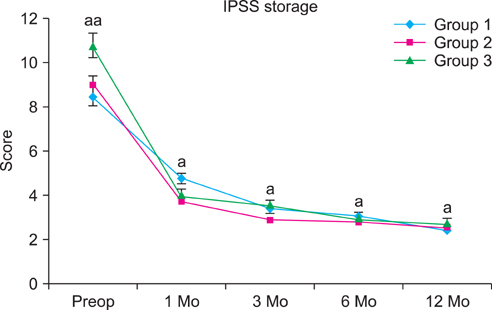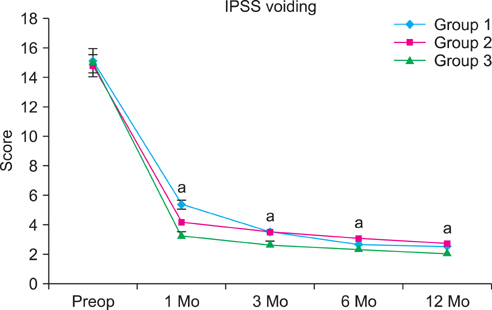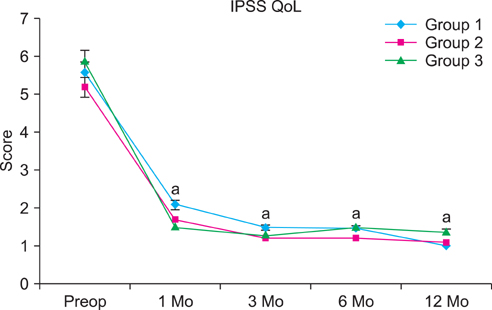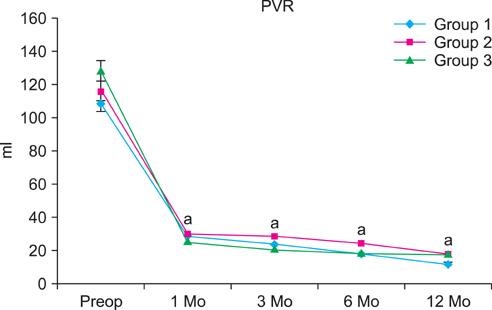Korean J Urol.
2012 Jul;53(7):472-477. 10.4111/kju.2012.53.7.472.
Influence of Intravesical Prostatic Protrusion on Preoperative Lower Urinary Tract Symptoms and Outcomes after 120 W High Performance System Laser Treatment in Men with Benign Prostatic Hyperplasia
- Affiliations
-
- 1Department of Urology, The Catholic University of Korea School of Medicine, Seoul, Korea. ksw1227@catholic.ac.kr
- KMID: 1988758
- DOI: http://doi.org/10.4111/kju.2012.53.7.472
Abstract
- PURPOSE
To evaluate the efficacy of photoselective vaporization of the prostate (PVP) with the 120 W Greenlight high performance system (HPS) laser for the treatment of benign prostatic hyperplasia (BPH) with intravesical prostatic protrusion (IPP).
MATERIALS AND METHODS
This study was conducted on 389 BPH patients who underwent PVP with the 120 W HPS laser from April 2009 to August 2011. The patients were divided into groups according to IPP: group I was defined as IPP of 0 to 5 mm (n=216), group II as IPP of 5 to 10 mm (n=135), and group III as IPP above 10 mm (n=38). Prostate volume, prostate-specific antigen, International Prostate Symptom Score (IPSS), maximal urinary flow rate (Qmax), and postvoid residual volume (PVR) were assessed and checked at postoperative 1, 3, 6, and 12 months.
RESULTS
There was a significant difference in the mean prostate size in each group (p<0.05). The preoperative total IPSS score, IPSS voiding symptom score, and quality of life score were not significantly different. However, the IPSS storage symptom score was significantly different between groups 1 and 2 and group 3. IPSS scores, Qmax, and PVR at postoperative 1, 3, 6, and 12 months showed significant improvement compared with preoperative values.
CONCLUSIONS
The degree of IPP can affect storage symptoms. However, there is no significant correlation between the degree of IPP and postoperative results. Also, the degree of IPP does not affect short- and long-term PVP results. Proper elimination of bladder outlet obstruction is important for symptomatic relief.
MeSH Terms
Figure
Reference
-
1. Berry SJ, Coffey DS, Walsh PC, Ewing LL. The development of human benign prostatic hyperplasia with age. J Urol. 1984. 132:474–479.2. Chapple CR, Roehrborn CG. A shifted paradigm for the further understanding, evaluation, and treatment of lower urinary tract symptoms in men: focus on the bladder. Eur Urol. 2006. 49:651–658.3. Girman CJ, Jacobsen SJ, Guess HA, Oesterling JE, Chute CG, Panser LA, et al. Natural history of prostatism: relationship among symptoms, prostate volume and peak urinary flow rate. J Urol. 1995. 153:1510–1515.4. Jacobsen SJ, Jacobson DJ, Girman CJ, Roberts RO, Rhodes T, Guess HA, et al. Natural history of prostatism: risk factors for acute urinary retention. J Urol. 1997. 158:481–487.5. Lieber MM, Jacobson DJ, McGree ME, St Sauver JL, Girman CJ, Jacobsen SJ. Intravesical prostatic protrusion in men in Olmsted County, Minnesota. J Urol. 2009. 182:2819–2824.6. Lim KB, Ho H, Foo KT, Wong MY, Fook-Chong S. Comparison of intravesical prostatic protrusion, prostate volume and serum prostatic-specific antigen in the evaluation of bladder outlet obstruction. Int J Urol. 2006. 13:1509–1513.7. Kuo HC. Clinical prostate score for diagnosis of bladder outlet obstruction by prostate measurements and uroflowmetry. Urology. 1999. 54:90–96.8. Keqin Z, Zhishun X, Jing Z, Haixin W, Dongqing Z, Benkang S. Clinical significance of intravesical prostatic protrusion in patients with benign prostatic enlargement. Urology. 2007. 70:1096–1099.9. Tan YH, Foo KT. Intravesical prostatic protrusion predicts the outcome of a trial without catheter following acute urine retention. J Urol. 2003. 170(6 Pt 1):2339–2341.10. Chia SJ, Heng CT, Chan SP, Foo KT. Correlation of intravesical prostatic protrusion with bladder outlet obstruction. BJU Int. 2003. 91:371–374.11. Te AE, Malloy TR, Stein BS, Ulchaker JC, Nseyo UO, Hai MA, et al. Photoselective vaporization of the prostate for the treatment of benign prostatic hyperplasia: 12-month results from the first United States multicenter prospective trial. J Urol. 2004. 172(4 Pt 1):1404–1408.12. Ruszat R, Wyler S, Forster T, Reich O, Stief CG, Gasser TC, et al. Safety and effectiveness of photoselective vaporization of the prostate (PVP) in patients on ongoing oral anticoagulation. Eur Urol. 2007. 51:1031–1038.13. Nose H, Foo KT, Lim KB, Yokoyama T, Ozawa H, Kumon H. Accuracy of two noninvasive methods of diagnosing bladder outlet obstruction using ultrasonography: intravesical prostatic protrusion and velocity-flow video urodynamics. Urology. 2005. 65:493–497.14. Styles RA, Neal DE, Griffiths CJ, Ramsden PD. Long-term monitoring of bladder pressure in chronic retention of urine: the relationship between detrusor activity and upper tract dilatation. J Urol. 1988. 140:330–334.15. Ochiai A, Kojima M. Correlation of ultrasound-estimated bladder weight with ultrasound appearance of the prostate and postvoid residual urine in men with lower urinary tract symptoms. Urology. 1998. 51:722–729.16. Dinis P, Silva J, Ribeiro MJ, Avelino A, Reis M, Cruz F. Bladder C-fiber desensitization induces a long-lasting improvement of BPH-associated storage LUTS: a pilot study. Eur Urol. 2004. 46:88–93.17. Donovan JL, Peters TJ, Neal DE, Brookes ST, Gujral S, Chacko KN, et al. A randomized trial comparing transurethral resection of the prostate, laser therapy and conservative treatment of men with symptoms associated with benign prostatic enlargement: the CLasP study. J Urol. 2000. 164:65–70.18. Housami F, Abrams P. Persistent detrusor overactivity after transurethral resection of the prostate. Curr Urol Rep. 2008. 9:284–290.19. Van Venrooij GE, Van Melick HH, Eckhardt MD, Boon TA. Correlations of urodynamic changes with changes in symptoms and well-being after transurethral resection of the prostate. J Urol. 2002. 168:605–609.20. Seki N, Yuki K, Takei M, Yamaguchi A, Naito S. Analysis of the prognostic factors for overactive bladder symptoms following surgical treatment in patients with benign prostatic obstruction. Neurourol Urodyn. 2009. 28:197–201.21. Yuen JS, Ngiap JT, Cheng CW, Foo KT. Effects of bladder volume on transabdominal ultrasound measurements of intravesical prostatic protrusion and volume. Int J Urol. 2002. 9:225–229.22. Mariappan P, Brown DJ, McNeill AS. Intravesical prostatic protrusion is better than prostate volume in predicting the outcome of trial without catheter in white men presenting with acute urinary retention: a prospective clinical study. J Urol. 2007. 178:573–577.23. Muir G, Gomez Sancha F, Bachmann A, Choi B, Collins E, de la Rosette J, et al. Techniques and training with GreenLight HPS 120-W laser therapy of the prostate: position paper. Euro Urol Suppl. 2008. 7:370–377.
- Full Text Links
- Actions
-
Cited
- CITED
-
- Close
- Share
- Similar articles
-
- Corrigendum: Acknowledgments. Effect of Photoselective Vaporization Prostatectomy on Lower Urinary Tract Symptoms in Benign Prostatic Hyperplasia With or Without Intravesical Prostatic Protrusion
- Current Trend of the Primary Treatment in Lower Urinary Tract Symptom/Benign Prostatic Hyperplasia
- 120 W Greenlight HPS Laser Photoselective Vaporization of the Prostate for Treatment of Benign Prostatic Hyperplasia in Men with Detrusor Underactivity
- Prostate Artery Embolization: Treatment of Symptomatic Benign Prostatic Hyperplasia
- Evaluation of preoperative high risk factors as score system in the management of genign prostatic hyperplasia







